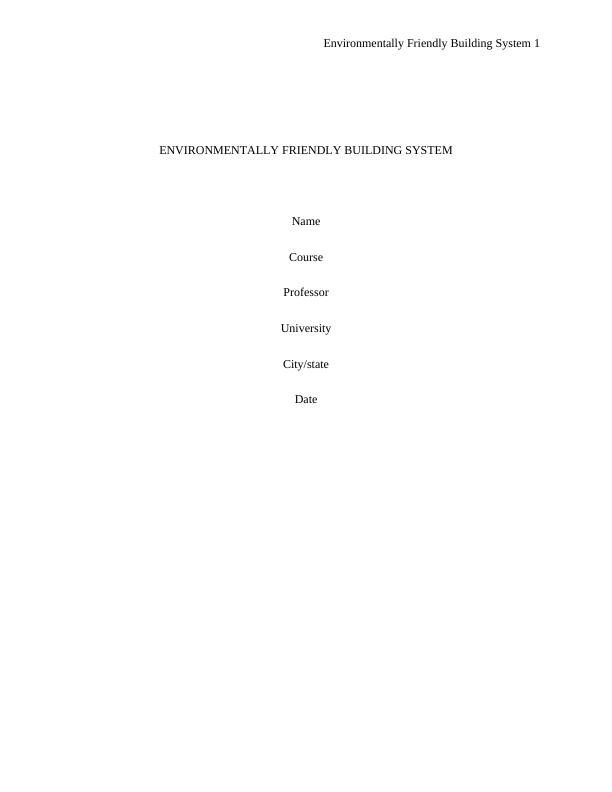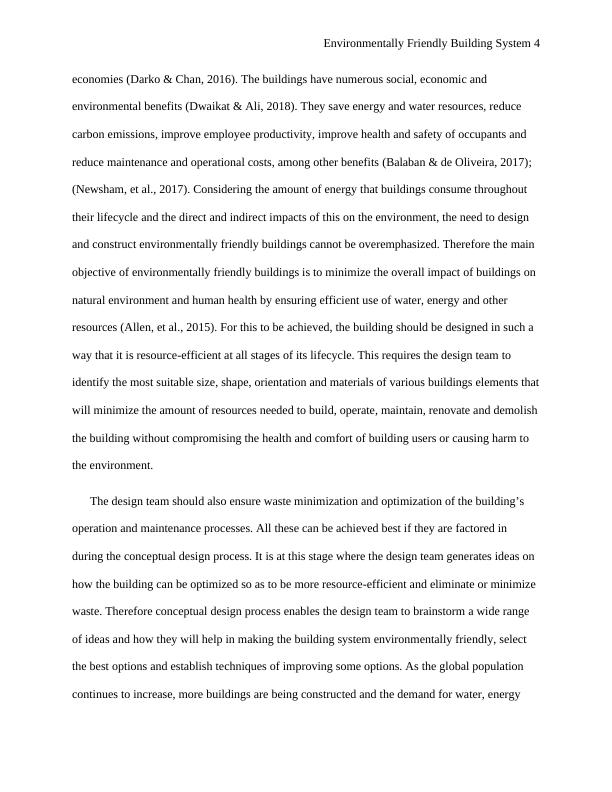Environmentally Friendly Building System
Added on 2023-06-08
17 Pages4446 Words73 Views
Environmentally Friendly Building System 1
ENVIRONMENTALLY FRIENDLY BUILDING SYSTEM
Name
Course
Professor
University
City/state
Date
ENVIRONMENTALLY FRIENDLY BUILDING SYSTEM
Name
Course
Professor
University
City/state
Date

Environmentally Friendly Building System 2
Table of Contents
1. Introduction.......................................................................................................................................3
2. Needs Definition.................................................................................................................................3
3. Conceptual Design Process...............................................................................................................5
4. Evaluation..........................................................................................................................................9
4.1. Site disturbance........................................................................................................................10
4.2. Building configuration and orientation..................................................................................10
4.3. Building materials....................................................................................................................10
4.4. Water systems and use............................................................................................................11
4.5. Energy systems and use...........................................................................................................12
4.6. Natural resources and processes.............................................................................................12
4.7. User behaviours.......................................................................................................................13
4.8. Monitoring tools.......................................................................................................................14
4.9. Automation...............................................................................................................................14
References................................................................................................................................................15
Table of Contents
1. Introduction.......................................................................................................................................3
2. Needs Definition.................................................................................................................................3
3. Conceptual Design Process...............................................................................................................5
4. Evaluation..........................................................................................................................................9
4.1. Site disturbance........................................................................................................................10
4.2. Building configuration and orientation..................................................................................10
4.3. Building materials....................................................................................................................10
4.4. Water systems and use............................................................................................................11
4.5. Energy systems and use...........................................................................................................12
4.6. Natural resources and processes.............................................................................................12
4.7. User behaviours.......................................................................................................................13
4.8. Monitoring tools.......................................................................................................................14
4.9. Automation...............................................................................................................................14
References................................................................................................................................................15

Environmentally Friendly Building System 3
1. Introduction
Buildings account for approximately 40% of global energy consumption. Consequently,
buildings have a significant impact on the environment. This provides a great opportunity to
reduce the amount of global energy demand and carbon emissions by increasing resource-
efficiency of buildings. The best way to achieve this is by designing buildings that are resource-
efficient throughout their lifecycle. Environmentally friendly buildings (also referred to as green
or sustainable buildings) are buildings that are resource-efficient at every stage of their lifecycle
– design stage, construction stage, operation stage, maintenance stage, renovation stage, and
demolition stage. Successful construction of an environmentally friendly building largely
depends on the effectiveness of design stage. It is during the design stage where ideas and
features that will make the building environmentally friendly are articulated. Every decision that
is made during the design stage has a direct impact on the amount of resources that the building
will requirement at different lifecycle stages. This also affects the cost of planning, constructing,
operating and maintaining the building (Fachrudin & Fachrudin, 2015); (Sitanggang & Susanto,
2017). Thus it is important to evaluate the environmental, economic and social impacts of design
ideas generated when designing an environmentally friendly building (Zuo, et al., 2016). The
design stage usually comprises of two main phases: preliminary or conceptual design phase and
final or detailed design phase. This report presents an appraisal of conceptual design process of
an environmentally friendly building system.
2. Needs Definition
Research and development projects of environmentally friendly buildings have been on the
rise over the past few years due to potential benefits of these buildings (Matisoff, et al., 2016).
These projects are being promoted all over the world, including in developed and developing
1. Introduction
Buildings account for approximately 40% of global energy consumption. Consequently,
buildings have a significant impact on the environment. This provides a great opportunity to
reduce the amount of global energy demand and carbon emissions by increasing resource-
efficiency of buildings. The best way to achieve this is by designing buildings that are resource-
efficient throughout their lifecycle. Environmentally friendly buildings (also referred to as green
or sustainable buildings) are buildings that are resource-efficient at every stage of their lifecycle
– design stage, construction stage, operation stage, maintenance stage, renovation stage, and
demolition stage. Successful construction of an environmentally friendly building largely
depends on the effectiveness of design stage. It is during the design stage where ideas and
features that will make the building environmentally friendly are articulated. Every decision that
is made during the design stage has a direct impact on the amount of resources that the building
will requirement at different lifecycle stages. This also affects the cost of planning, constructing,
operating and maintaining the building (Fachrudin & Fachrudin, 2015); (Sitanggang & Susanto,
2017). Thus it is important to evaluate the environmental, economic and social impacts of design
ideas generated when designing an environmentally friendly building (Zuo, et al., 2016). The
design stage usually comprises of two main phases: preliminary or conceptual design phase and
final or detailed design phase. This report presents an appraisal of conceptual design process of
an environmentally friendly building system.
2. Needs Definition
Research and development projects of environmentally friendly buildings have been on the
rise over the past few years due to potential benefits of these buildings (Matisoff, et al., 2016).
These projects are being promoted all over the world, including in developed and developing

Environmentally Friendly Building System 4
economies (Darko & Chan, 2016). The buildings have numerous social, economic and
environmental benefits (Dwaikat & Ali, 2018). They save energy and water resources, reduce
carbon emissions, improve employee productivity, improve health and safety of occupants and
reduce maintenance and operational costs, among other benefits (Balaban & de Oliveira, 2017);
(Newsham, et al., 2017). Considering the amount of energy that buildings consume throughout
their lifecycle and the direct and indirect impacts of this on the environment, the need to design
and construct environmentally friendly buildings cannot be overemphasized. Therefore the main
objective of environmentally friendly buildings is to minimize the overall impact of buildings on
natural environment and human health by ensuring efficient use of water, energy and other
resources (Allen, et al., 2015). For this to be achieved, the building should be designed in such a
way that it is resource-efficient at all stages of its lifecycle. This requires the design team to
identify the most suitable size, shape, orientation and materials of various buildings elements that
will minimize the amount of resources needed to build, operate, maintain, renovate and demolish
the building without compromising the health and comfort of building users or causing harm to
the environment.
The design team should also ensure waste minimization and optimization of the building’s
operation and maintenance processes. All these can be achieved best if they are factored in
during the conceptual design process. It is at this stage where the design team generates ideas on
how the building can be optimized so as to be more resource-efficient and eliminate or minimize
waste. Therefore conceptual design process enables the design team to brainstorm a wide range
of ideas and how they will help in making the building system environmentally friendly, select
the best options and establish techniques of improving some options. As the global population
continues to increase, more buildings are being constructed and the demand for water, energy
economies (Darko & Chan, 2016). The buildings have numerous social, economic and
environmental benefits (Dwaikat & Ali, 2018). They save energy and water resources, reduce
carbon emissions, improve employee productivity, improve health and safety of occupants and
reduce maintenance and operational costs, among other benefits (Balaban & de Oliveira, 2017);
(Newsham, et al., 2017). Considering the amount of energy that buildings consume throughout
their lifecycle and the direct and indirect impacts of this on the environment, the need to design
and construct environmentally friendly buildings cannot be overemphasized. Therefore the main
objective of environmentally friendly buildings is to minimize the overall impact of buildings on
natural environment and human health by ensuring efficient use of water, energy and other
resources (Allen, et al., 2015). For this to be achieved, the building should be designed in such a
way that it is resource-efficient at all stages of its lifecycle. This requires the design team to
identify the most suitable size, shape, orientation and materials of various buildings elements that
will minimize the amount of resources needed to build, operate, maintain, renovate and demolish
the building without compromising the health and comfort of building users or causing harm to
the environment.
The design team should also ensure waste minimization and optimization of the building’s
operation and maintenance processes. All these can be achieved best if they are factored in
during the conceptual design process. It is at this stage where the design team generates ideas on
how the building can be optimized so as to be more resource-efficient and eliminate or minimize
waste. Therefore conceptual design process enables the design team to brainstorm a wide range
of ideas and how they will help in making the building system environmentally friendly, select
the best options and establish techniques of improving some options. As the global population
continues to increase, more buildings are being constructed and the demand for water, energy

End of preview
Want to access all the pages? Upload your documents or become a member.
Related Documents
Aspects of Conceptual Design Phase, Green Designlg...
|13
|3319
|41
Environmental Management for Sustainable Developmentlg...
|11
|1545
|399
Environmental Sustainability in Construction - Doclg...
|9
|2386
|47
Environmental Building Design | Assignmentlg...
|9
|1896
|125
CSM80002 Environmental Sustainabilitylg...
|5
|1619
|63
Environmentally Conscious Building || System Engineering Design Assignment - EMSE 6805lg...
|14
|2899
|51
